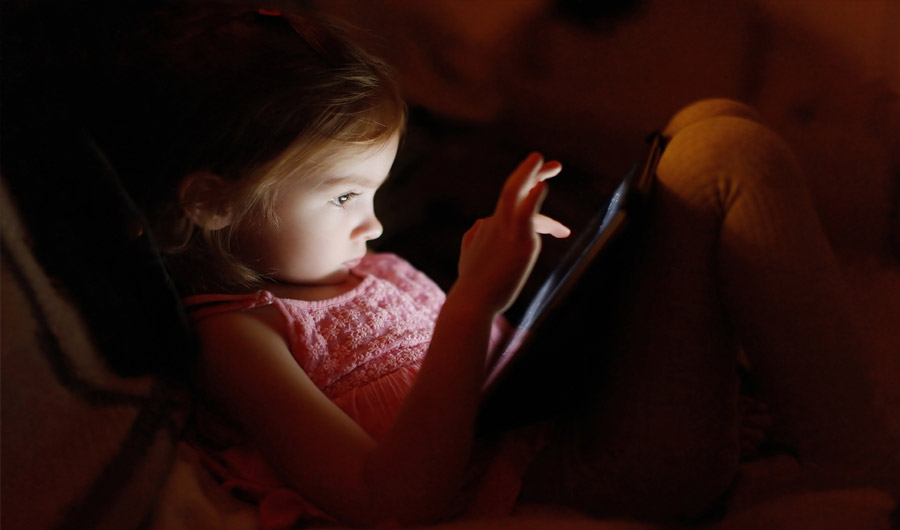Using Electronic Devices Before Bed Tied to Lousy Sleep

(Inside Science) -- An ever-present, always-updating barrage of email, tweets, headlines and “likes” on smartphones and tablets is worsening the sleep quality of adults and children. Its consequences don't simply prompt an extra cup of coffee in the morning. Poor sleep is associated with obesity, diabetes, depression and other health disorders, and researchers suspect that use of smartphones at night is making the problem worse. A pair of new studies shows the flood of light isn’t the only problem; it’s the flood of information, too.
In the past few years, researchers have shown self-illuminated devices like smartphones, e-readers and tablets bathe users’ eyes in blue light, which suppresses the darkness hormone melatonin and makes it harder to fall asleep. Some devices, websites and apps have responded by offering “night modes,” which shift the device’s light output to redder ends of the spectrum that may be less stimulating to the eyes and brain. Despite these efforts, researchers continue to notice increasing psychological effects apart from the suppression of melatonin. Two studies released in the past two weeks demonstrate that smartphone use at night, especially near bedtime, directly contributes to sleep loss -- for physiological and psychological reasons.
“You say dim down your screen, you may filter it out so there is less impact, but you are still activating your brain,” said Mariana Figueiro, program director of the Lighting Research Center at Rensselaer Polytechnic Institute, who studies light’s effects on circadian rhythms and who was not involved in the new studies. “It’s not necessarily just the physiological effects of light on melatonin suppression.”
In one study, Matthew Christensen, Greg Marcus and colleagues from the University of California, San Francisco tracked the sleep quality and smartphone use of 653 adults for 30 days. They found that longer screen time was associated with less sleep and poor sleep quality, especially when the participants used their phones at bedtime.
It’s the first study to measure phone exposure and sleep in real time, rather than asking people to report their use after the fact, Marcus said. The participants are enrolled in a larger project called the Health eHeart Study, which enables researchers to track phone use along with a variety of health metrics. Ultimately, phone use was not associated with any increase or decrease in physical activity, as some researchers suspected, but it was strongly associated with sleep loss.
Using a phone or tablet around bedtime, Marcus said, “was associated with longer sleep latency, or taking longer to get to sleep, and poor sleep quality."
The study appears Nov. 9 in the journal PLoS One. It couldn't exclude the possibility that poor sleep itself can lead to more screen time -- in other words, insomnia might prompt people to pick up their phones -- but it bolsters the idea that bedtime smartphone use is bad for sleep, Marcus said.
“We weren’t able to identify the specific mechanism responsible, whether it was the light or the emotional upset of content,” he said. “But there’s certainly no evidence that screen time helps with quality of sleep, let’s put it that way.”
The report comes on the heels of a review of 20 other studies that showed kids using portable media devices around bedtime were twice as likely to have shorter sleep times. In a twist, the same was true for kids who had access to their devices but didn’t use them, according to Ben Carter, a statistician at King’s College London and lead author of the paper, which appeared Oct. 31 in Pediatrics.
“It’s well established that if you use your device near bedtime, 90 minutes before you try to initiate sleep, you have poorer sleep outcomes. That’s compared to children who didn’t have access to a device. But the second finding is more surprising,” Carter said. “If you don’t use the device, but have access to the device in the sleep environment, you again find much poorer sleep outcomes.”
Carter included studies that covered more than 125,000 children ages 6 to 19 and measured exposure to devices such as tablets and smartphones. He deliberately excluded television and computer use, arguing that portable devices pose a higher likelihood of interaction with peers. The results show that use of media devices at night was linked with difficulty falling asleep, difficulty staying asleep, lack of enough sleep -- less than 10 hours for children and less than nine hours for teens -- and lack of function the next day because of being overtired.
Marcus and Carter both say the temptation to use an illuminated device may be as disruptive as the light that streams from it.
A recent National Sleep Foundation poll showed that half of school-age children in America have active, light-emitting electronic devices in their bedrooms. More than two-thirds of older teens (15-17 years old) leave an electronic device on while sleeping, according to an editorial accompanying Carter’s study. Carter said he is guilty of constantly checking his phone.
Figueiro is measuring brain activity in people who use their smartphones at night. She has found that people who expose themselves to screens before bedtime are getting less REM sleep, and perform more poorly the following day on tasks designed to measure alertness.
“If you’re doing something exciting on your phone, you’re still going to be alerted by that. You can use all the filtering you want; you’re still going to be playing games with your brain,” she said.
Carter thinks the solution is relatively easy, however: Don’t look at your phone at bedtime. To remove temptation, take it out of the bedroom entirely. He says parents should take away children’s devices 90 minutes before bedtime -- and while they’re at it, put away their own phones, too.
“If every child in the school has put their phone away, there is no chance of interaction,” he said. “I think the more we talk about it, the more likely people are going to think about their own usage.”

